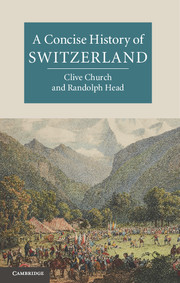Book contents
- Frontmatter
- Contents
- List of Illustrations
- List of Figures
- List of Maps
- Acknowledgements
- List of Abbreviations
- Introduction Making the Swiss
- 1 Before Switzerland
- 2 Creating the Swiss Confederacy, 1386–1520
- 3 A divided Switzerland in Reformation Europe, 1515–1713
- 4 The Ancien Régime, 1713–1798
- 5 Revolution and contention, 1798–1848
- 6 Forging the new nation, 1848–1914
- 7 The shocks of war, 1914–1950
- 8 The Sonderfall years, 1950–1990
- 9 Since 1989
- Chronology
- Glossary
- Further Reading
- Index
7 - The shocks of war, 1914–1950
Published online by Cambridge University Press: 05 June 2013
- Frontmatter
- Contents
- List of Illustrations
- List of Figures
- List of Maps
- Acknowledgements
- List of Abbreviations
- Introduction Making the Swiss
- 1 Before Switzerland
- 2 Creating the Swiss Confederacy, 1386–1520
- 3 A divided Switzerland in Reformation Europe, 1515–1713
- 4 The Ancien Régime, 1713–1798
- 5 Revolution and contention, 1798–1848
- 6 Forging the new nation, 1848–1914
- 7 The shocks of war, 1914–1950
- 8 The Sonderfall years, 1950–1990
- 9 Since 1989
- Chronology
- Glossary
- Further Reading
- Index
Summary
In 1914 Switzerland was a self-confident and relatively democratic part of the European state system. However, the effects of two world wars and the intervening depression were to test Swiss cohesion and prosperity. The First World War pressed Swiss neutrality hard, especially where linguistic unity and economic security were concerned. The resulting tensions led to an explosion at the end of the war that sent the country off in new political directions, both domestically and diplomatically. The inter-war period brought further extreme economic problems, combined with violent new divisions, often stimulated from outside.
Faced with growing European tensions in the 1930s, the Swiss began to batten down the hatches and prepare to defend themselves against external threats, first through better preparation and unity than in 1914, and then through the defensive strategy known as the Reduit. Even so, they did not avoid problems, being sucked into the German war economy and, from 1944, into difficulties with the Allies. Switzerland emerged from the war proud, because the Swiss had survived by strengthening their own democratic unity and resources, but also isolated and mistrusted. In fact, overall, the country had suffered more from events in Europe and beyond than many outside realized.
- Type
- Chapter
- Information
- A Concise History of Switzerland , pp. 193 - 226Publisher: Cambridge University PressPrint publication year: 2013



